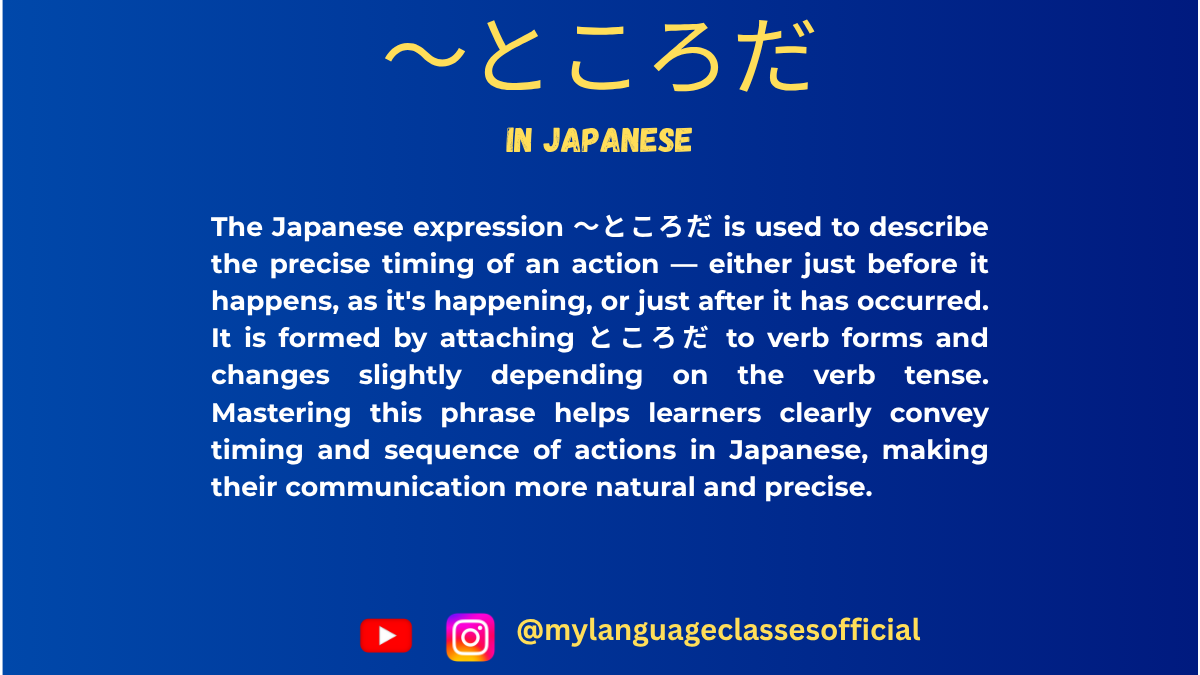Your cart is currently empty!
Tag: Japanese Expressions
-
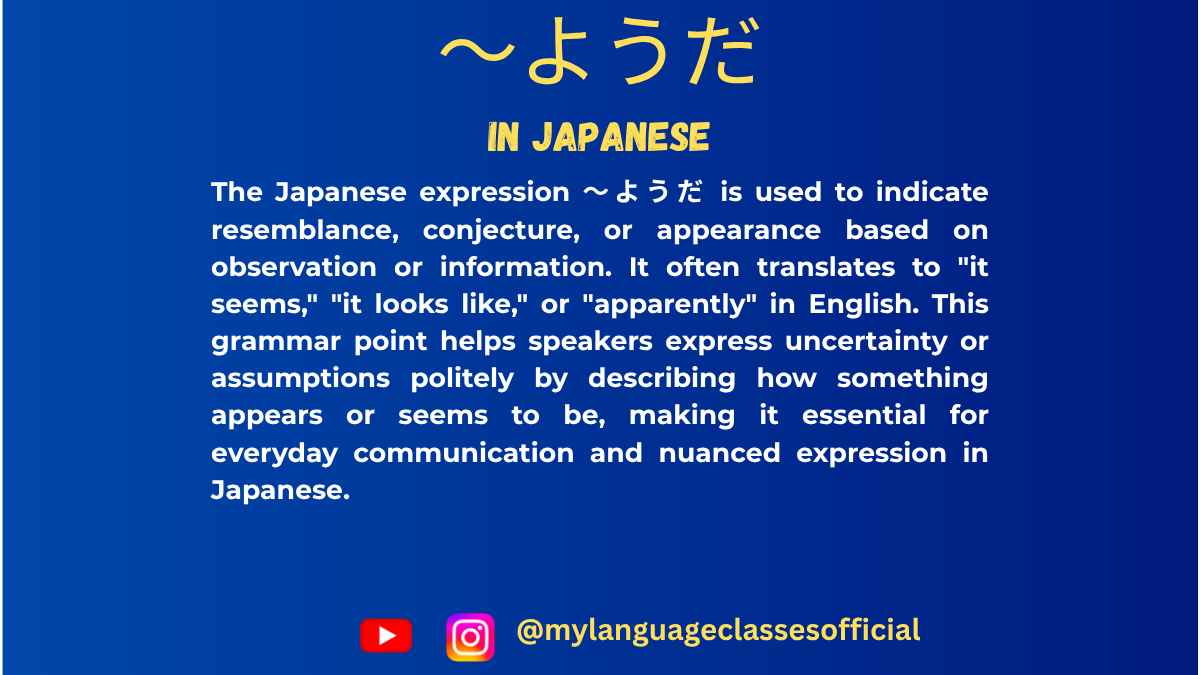
Understanding 〜ようだ in Japanese | My Language Classes
Understanding 〜ようだ in Japanese
The Japanese expression 〜ようだ (you da) is used to indicate resemblance, assumption, or conjecture based on observable evidence. It often translates to “seems like,” “appears to be,” or “looks like” in English. This form is frequently used in both spoken and written Japanese to express an impression based on visual or contextual clues rather than firsthand knowledge.
Formation of 〜ようだ
1. With Verbs:
- Formation:
- Verb (dictionary form) + ようだ
- Verb (ta-form) + ようだ (past tense)
2. With Nouns:
- Formation:
- Noun + のようだ
3. With Adjectives:
- i-Adjectives:
- Adjective (plain form) + ようだ
- na-Adjectives:
- Adjective (stem) + なようだ
Usage of 〜ようだ
- Expressing Appearance – Used when something visually appears a certain way.
- Expressing Similarity – Used to compare something to another thing.
- Expressing Assumption – Used to make an educated guess based on observed facts.
- Expressing Uncertainty – Used to indicate something that is not confirmed.
Situations where 〜ようだ is used
- When making an assumption based on visual clues.
- When describing a person’s behavior resembling something.
- When comparing one thing to another.
- When describing a feeling or state that is not directly observable.
- When indicating a metaphorical expression.
Examples of Verbs, Nouns, and Adjectives with 〜ようだ
Word Type Base Word 〜ようだ Form Example Sentence Romaji Meaning Verb 食べる (taberu) 食べるようだ あの子はよく食べるようだ。 Ano ko wa yoku taberu you da. That child seems to eat a lot. Verb 雨が降る (ame ga furu) 雨が降るようだ 突然暑くなったから雨が降るようだ。 Totsuzen atsuku natta kara ame ga furu you da. It suddenly got hot, so it looks like it’s going to rain. Verb 走る (hashiru) 走るようだ 子供が快速に走るようだ。 Kodomo ga kaisoku ni hashiru you da. The child seems to be running fast. Noun 神様 (kami-sama) 神様のようだ 他の行動は神様のようだ。 Kare no koudou wa kami-sama no you da. His actions are like those of a god. Adjective 青い (aoi) 青いようだ 水が青いようだ。 Mizu ga aoi you da. The water seems to be blue.
More Example Sentences
- 他の思い通りのようだ。
Tano omoi doori no you da. (It seems to be just as he thought.) - 子供はおなかがすいたようだ。
Kodomo wa onaka ga suita you da. (The child seems to be hungry.) - 家の外は非常に冷たいようだ。
Ie no soto wa hijou ni tsumetai you da. (It seems to be extremely cold outside.)
Things to Keep in Mind
- 〜ようだ is different from 〜そうだ, which is used for hearsay or direct appearance.
- It cannot be used for one’s own direct experiences.
- 〜ようだ can be formal or casual depending on context.
Fill in the Blanks
- 大きな壁が倒れる\u_____
- その人はエンジニア\uの\u_____
- 雨が降りそう\u_____
- 私の猫は子猫の\u_____
- その子は疲れている\u_____
- その風は強い\u_____
- かれの勝利は確実の_____
Answers
- ようだ
- ようだ
- ようだ
- ようだ
- ようだ
- ようだ
- ようだ
Conclusion
〜ようだ is a crucial structure in Japanese that allows speakers to express assumptions, resemblance, and indirect knowledge. Mastering this form helps in making more natural and nuanced statements in Japanese conversations and writing.
If you enjoyed this lesson, be sure to check out more posts like this on my blog at My Language Classes. Don’t forget to subscribe my YouTube channel and follow me on Instagram for the latest language learning tips and lessons. Leave a comment below to share your thoughts, or ask any questions you have about nouns.
Happy learning! 😊
- Formation:
-
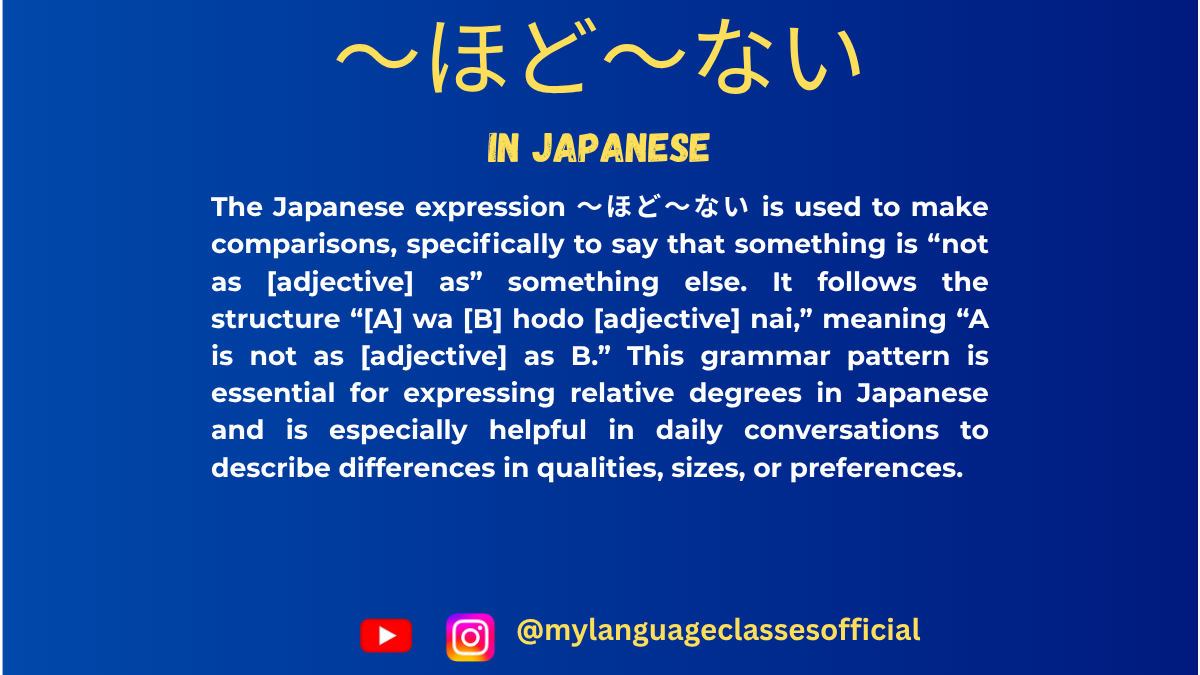
Using 〜ほど〜ない in Japanese | My Language Classes
Understanding 〜ほど〜ない in Japanese
The Japanese grammar pattern 「〜ほど〜ない」 is commonly used for making comparisons and expressing degree or extent. It implies that something is “not as much as” something else. This phrase is often translated as “not as… as…” in English.
Basic Structure of 〜ほど〜ない
The structure of this grammar pattern is as follows:
Noun + ほど + Adjective (ない-form)
or
Verb (dictionary form) + ほど + Adjective (ない-form)
General Meaning
「A ほど B ない」 means that B is not as A.
- A is the standard of comparison.
- B is the thing being compared.
Examples:
- この町は東京ほど賑やかではない。
(Kono machi wa Tōkyō hodo nigiyaka de wa nai.)
→ This town is not as lively as Tokyo. - 彼は私ほど速く走れない。
(Kare wa watashi hodo hayaku hashirenai.)
→ He cannot run as fast as I do. - この問題は思ったほど難しくない。
(Kono mondai wa omotta hodo muzukashiku nai.)
→ This problem is not as difficult as I thought.
Situations Where 〜ほど〜ない is Used
1. Comparing Extent or Degree
- Used when two things are compared, but the second one (B) has less intensity than the first (A).
Example:
北海道の冬は東京の冬ほど寒くない。
(Hokkaidō no fuyu wa Tōkyō no fuyu hodo samuku nai.)
→ Hokkaido’s winter is not as cold as Tokyo’s winter.2. Expressing Subjective Opinions
- Often used to express personal opinions about differences in perception.
Example:
数学は国語ほど難しくないと思います。
(Sūgaku wa kokugo hodo muzukashiku nai to omoimasu.)
→ I think math is not as difficult as Japanese.3. Negative Comparison in Abilities or Characteristics
- Used when comparing someone’s ability or characteristics with another’s.
Example:
彼の英語は先生ほど上手ではない。
(Kare no eigo wa sensei hodo jōzu de wa nai.)
→ His English is not as good as the teacher’s.4. Comparing Expectations vs Reality
- Used when expectations were high, but the actual situation is not as expected.
Example:
この映画は評判ほど面白くない。
(Kono eiga wa hyōban hodo omoshiroku nai.)
→ This movie is not as interesting as its reputation suggests.5. Comparing Feelings and Emotions
- Used when talking about feelings that are not as strong as expected.
Example:
彼は私が思ったほど優しくない。
(Kare wa watashi ga omotta hodo yasashiku nai.)
→ He is not as kind as I thought.6. Comparing Physical Condition or Health
- Used to compare health conditions or physical states.
Example:
風邪は思ったほどひどくない。
(Kaze wa omotta hodo hidoku nai.)
→ The cold is not as bad as I thought.7. Comparing Amount or Frequency
- Used when comparing quantity or frequency of actions.
Example:
今日は昨日ほど忙しくない。
(Kyō wa kinō hodo isogashiku nai.)
→ Today is not as busy as yesterday.8. Comparing Importance or Necessity
- Used when comparing levels of importance or necessity.
Example:
宿題はテストほど大事ではない。
(Shukudai wa tesuto hodo daiji de wa nai.)
→ Homework is not as important as tests.9. Comparing Strength of Desire or Preference
- Used to compare desires, preferences, or interests.
Example:
私は映画を見るのが好きですが、本を読むほど好きではない。
(Watashi wa eiga o miru no ga suki desu ga, hon o yomu hodo suki de wa nai.)
→ I like watching movies, but not as much as reading books.
Key Points to Remember About 〜ほど〜ない
- It is used for making comparisons where the second element has less intensity.
- It is often used to express subjective opinions.
- It is used to compare expectations vs reality.
- It can be used in various contexts: ability, frequency, amount, physical conditions, and emotions.
- It follows a simple pattern: “A ほど B ない”, where A is the standard, and B is the thing being compared.
Conclusion
The 「〜ほど〜ない」 grammar pattern is an essential part of Japanese when making negative comparisons. Mastering it will help you express your opinions, compare things effectively, and sound more natural in conversations. Make sure to practice using this structure in daily life to reinforce your understanding!
If you enjoyed this lesson, be sure to check out more posts like this on my blog at My Language Classes. Don’t forget to subscribe my YouTube channel and follow me on Instagram for the latest language learning tips and lessons. Leave a comment below to share your thoughts, or ask any questions you have about nouns.
Happy learning! 😊
-
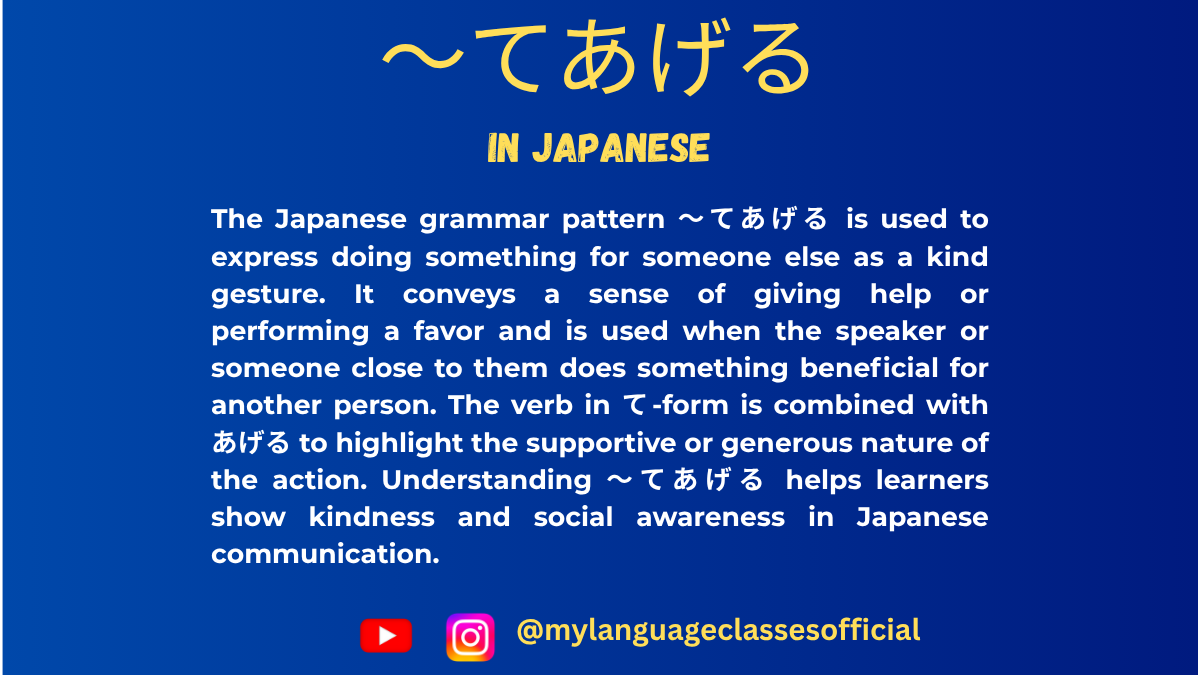
How to Use 〜てあげる | My Language Classes
〜てあげる: To Give (an Action) in Japanese
When learning Japanese, you will often encounter the phrase 〜てあげる (te ageru), which means “to give (an action).” This phrase is used when the speaker or someone performs a beneficial action for another person. The nuance of 〜てあげる is that the action is done out of kindness or generosity.
How to Use 〜てあげる
The structure is simple:
[Person] は [Recipient] に [Action in 〜て-form] + あげる
Example:
- わたしは ともだち に 本を 貸してあげました。
(Watashi wa tomodachi ni hon o kashite agemashita.)
→ I lent a book to my friend (as a favor).
Different Forms of 〜てあげる
The verb あげる can be conjugated into different forms to match the politeness level:
Form Usage 〜てあげる Casual/plain form 〜てあげます Polite form 〜てあげて Te-form for requests 〜てあげない Negative form (not doing the action) 〜てあげなかった Past negative form Situations Where 〜てあげる Is Used
1. Doing Something Nice for Someone Else
- わたしは ちょうとせんせい に にもつを 持ってあげました。
(Watashi wa chouto sensei ni nimotsu o motte agemashita.)
→ I carried the teacher’s luggage for them.
2. Helping Someone
- おとうさんは ぼくに 自転車の修理を してあげた。
(Otousan wa boku ni jitensha no shuuri o shite ageta.)
→ Dad fixed my bicycle for me.
3. Giving Advice or Instruction
- わたしは ともだち に 日本語 を 教えてあげる。
(Watashi wa tomodachi ni nihongo o oshiete ageru.)
→ I will teach my friend Japanese.
4. Buying Something for Someone
- おかあさんは いもうと に 花を 買ってあげました。
(Okaasan wa imouto ni hana o katte agemashita.)
→ Mom bought flowers for my little sister.
5. Making a Favorable Gesture
- 私は 友達 に コーヒーを 作ってあげました。
(Watashi wa tomodachi ni koohii o tsukutte agemashita.)
→ I made coffee for my friend.
6. Expressing Kindness in a Relationship
- けんたろうは かのじょに マッサージを かいてあげた。
(Kentaro wa kanojo ni massaaji o kaite ageta.)
→ Kentaro gave his girlfriend a massage.
7. Helping Children or Animals
- おねえさんは 犬 に 食べ物 を あげてあげた。
(Oneesan wa inu ni tabemono o agete ageta.)
→ The older sister gave food to the dog.
Things to Remember About 〜てあげる
- Used when the action is beneficial: You should only use 〜てあげる when the action is helpful or kind.
- Do not use for superiors: Avoid using 〜てあげる when speaking about actions for a superior (e.g., boss, teacher) as it may sound rude. Instead, use 〜てさしあげる.
- Casual tone: This phrase is often used in informal or everyday conversations rather than in formal writing.
Summary Table: When to Use 〜てあげる
Situation Example Helping a friend はさみを 買ってあげた。 (Bought scissors for them.) Teaching someone えいご を 教えてあげる。 (Teach English to them.) Doing a favor 部屋を 掃除してあげる。 (Clean the room for them.) Helping animals 犬 に 飯 を あげてあげる。 (Give food to a dog.) By mastering 〜てあげる, you can express kindness and generosity in Japanese naturally! Practice using it in real conversations to make your speech sound more fluent and native-like.
Do you have any questions about 〜てあげる? Let me know in the comments!
If you enjoyed this lesson, be sure to check out more posts like this on my blog at My Language Classes. Don’t forget to subscribe my YouTube channel and follow me on Instagram for the latest language learning tips and lessons. Leave a comment below to share your thoughts, or ask any questions you have about nouns.
Happy learning! 😊
- わたしは ともだち に 本を 貸してあげました。
-
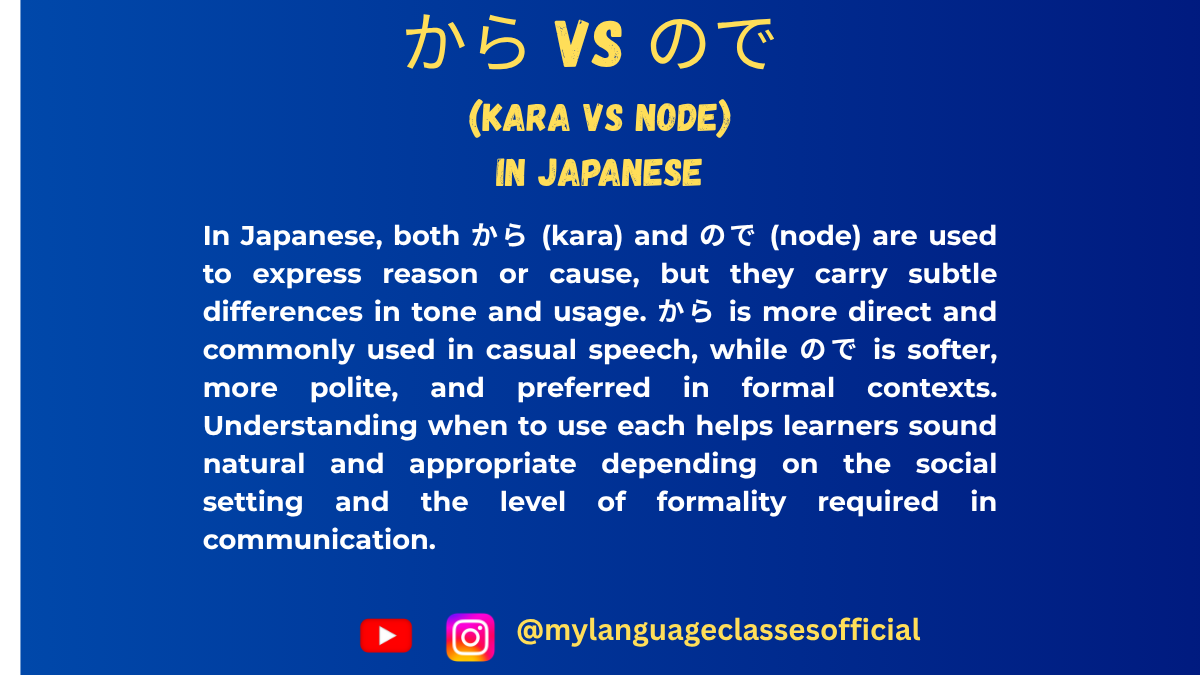
How to Say “Because” in Japanese から (kara) vs. ので (node) | My Language Classes
Expressing “Because” in Japanese: から (kara) vs. ので (node)
When learning Japanese, understanding how to express “because” is essential for forming logical connections in your sentences. Two primary tools for this are から (kara) and ので (node). Both translate roughly to “because” or “since,” but their nuances and appropriate contexts differ. In this post, we’ll explore their meanings, usage, and subtle differences to help you master them.
1. Understanding から (kara)
から is a versatile and commonly used particle to indicate cause and effect. Its usage is straightforward and can be found in both casual and formal contexts, though it often leans more casual.
Structure:
- Reason + から + Result
- Example: 勉強しなかったから、試験に落ちました。
(Benkyou shinakatta kara, shiken ni ochimashita.)
“Because I didn’t study, I failed the exam.”
- Example: 勉強しなかったから、試験に落ちました。
Key Features:
- Direct and Conversational:
から is widely used in everyday speech. It gives a clear and sometimes blunt explanation of reasons.- Example: 雨が降っているから、外に行きません。
(Ame ga futteiru kara, soto ni ikimasen.)
“Because it’s raining, I won’t go outside.”
- Example: 雨が降っているから、外に行きません。
- Flexible Placement:
You can use から in both written and spoken Japanese, though it feels more natural in informal contexts. - Focus on the Speaker’s Perspective:
The reason expressed with から often reflects the speaker’s opinion or justification.
2. Understanding ので (node)
ので is another way to express “because,” but it has a softer, more polite tone. It’s commonly used in formal situations or when you want to sound less direct or imposing.
Structure:
- Reason + ので + Result
- Example: 雨が降っているので、外に行きません。
(Ame ga futteiru node, soto ni ikimasen.)
“Since it’s raining, I won’t go outside.”
- Example: 雨が降っているので、外に行きません。
Key Features:
- Polite and Subtle:
ので carries a sense of consideration, making it ideal for formal or respectful conversations.- Example: お腹が空いたので、何か食べましょう。
(Onaka ga suita node, nanika tabemashou.)
“Since I’m hungry, let’s eat something.”
- Example: お腹が空いたので、何か食べましょう。
- Softer Implications:
Compared to から, ので feels less assertive and more explanatory. It’s often used when the reason is more objective or when you’re asking for understanding. - Common in Formal Writing and Speech:
You’ll frequently see ので in polite correspondence, workplace conversations, and when addressing superiors.
3. Key Differences Between から and ので
Aspect から ので Tone Direct, casual Polite, formal, soft Usage Everyday conversations Formal writing and respectful speech Reason Type Subjective or personal Objective or neutral Politeness Level Casual to neutral Neutral to polite Examples Highlighting the Differences:
- Casual Statement:
- 勉強しなかったから、試験に落ちた。 (Benkyou shinakatta kara, shiken ni ochita.)
“I failed the exam because I didn’t study.” (Direct and casual) - 勉強しなかったので、試験に落ちました。 (Benkyou shinakatta node, shiken ni ochimashita.)
“I failed the exam since I didn’t study.” (Polite and explanatory)
- 勉強しなかったから、試験に落ちた。 (Benkyou shinakatta kara, shiken ni ochita.)
- Polite Request:
- 道が混んでいたから、遅れました。 (Michi ga kondeita kara, okuremashita.)
“I was late because the roads were crowded.” (Blunt explanation) - 道が混んでいたので、遅れました。 (Michi ga kondeita node, okuremashita.)
“I was late since the roads were crowded.” (Polite and considerate)
- 道が混んでいたから、遅れました。 (Michi ga kondeita kara, okuremashita.)
4. When to Use Which?
Use から When:
- Speaking casually with friends or family.
- Explaining personal reasons directly.
- Adding emphasis to the cause-effect relationship.
Use ので When:
- Communicating in formal or polite settings.
- Writing formal letters, essays, or workplace emails.
- Explaining reasons with a softer tone to avoid sounding blunt.
5. A Quick Note on Grammar
- から connects to the plain form of a verb, adjective, or noun:
- Verb: 走るから (Hashiru kara, “Because I run”)
- Adjective: 寒いから (Samui kara, “Because it’s cold”)
- Noun + だ: 先生だから (Sensei da kara, “Because I’m a teacher”)
- ので also connects to the plain form, but nouns and な-adjectives require な before ので:
- Verb: 走るので (Hashiru node, “Since I run”)
- Adjective: 寒いので (Samui node, “Since it’s cold”)
- Noun + な: 先生なので (Sensei na node, “Since I’m a teacher”)
6. Practice Makes Perfect!
Understanding から and ので is only the beginning. Try using them in sentences to express reasons for daily activities. For example:
- 電車が遅れたから、会議に間に合いませんでした。
(Densha ga okureta kara, kaigi ni ma ni aimasendeshita.)
“Because the train was delayed, I couldn’t make it to the meeting.” - 電車が遅れたので、会議に間に合いませんでした。
(Densha ga okureta node, kaigi ni ma ni aimasendeshita.)
“Since the train was delayed, I couldn’t make it to the meeting.”
By practicing these expressions in context, you’ll develop an intuitive sense of when to use から and ので, enhancing both your fluency and sensitivity to Japanese communication styles. Keep practicing, and don’t hesitate to mix them into your conversations!
If you enjoyed this lesson, be sure to check out more posts like this on my blog at My Language Classes. Don’t forget to subscribe my YouTube channel and follow me on Instagram for the latest language learning tips and lessons. Leave a comment below to share your thoughts, or ask any questions you have about nouns.
Happy learning! 😊
- Reason + から + Result

